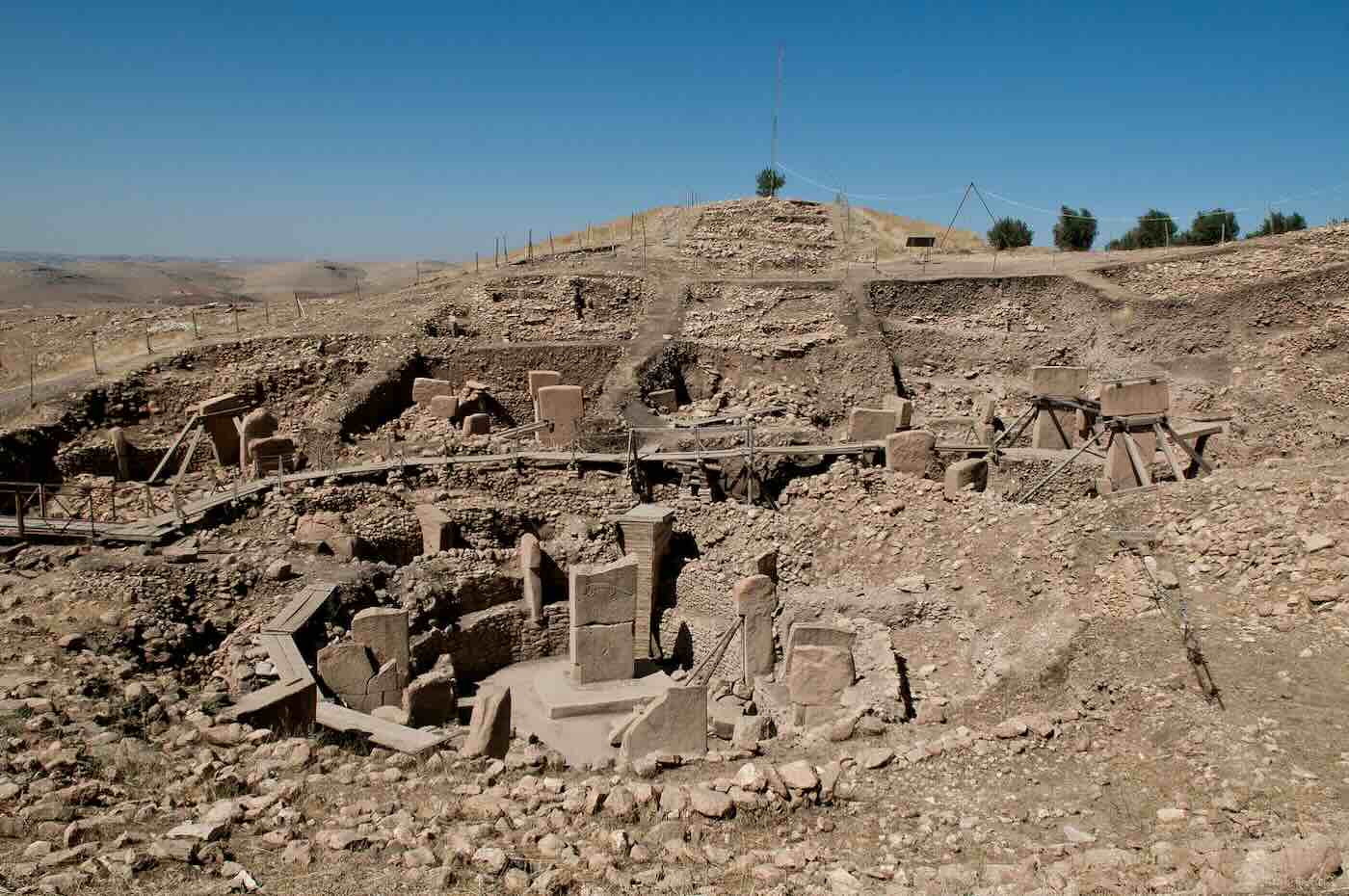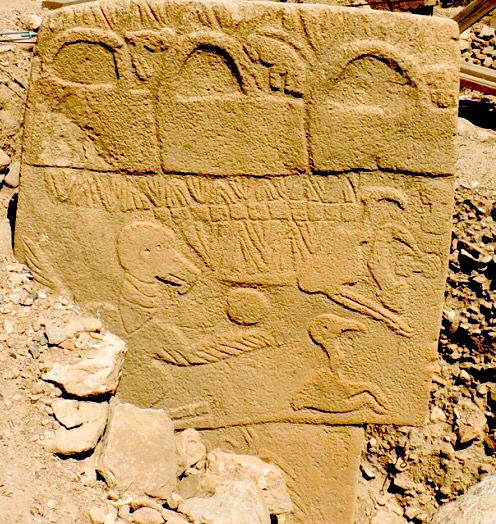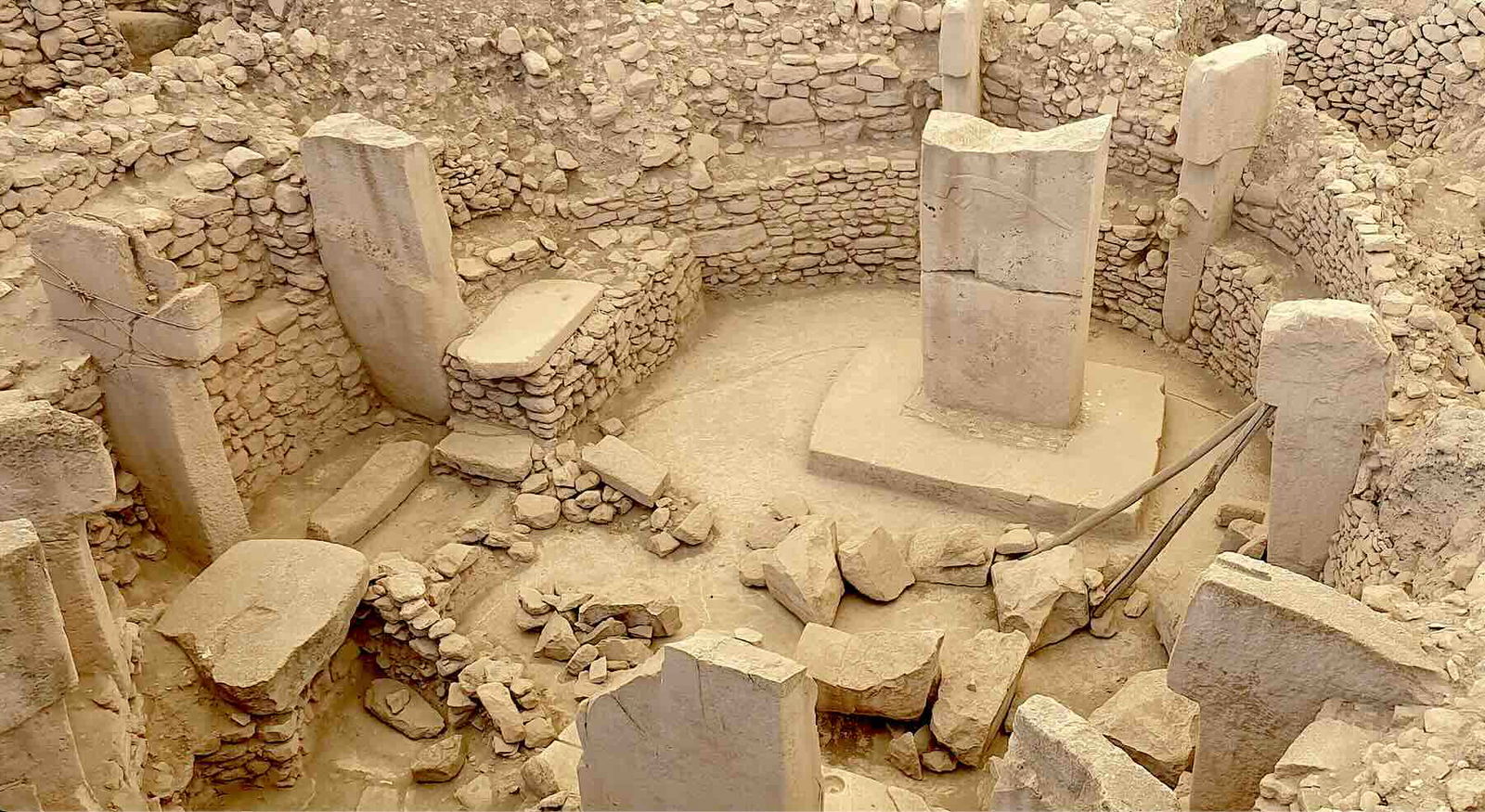11,500 years ago, the early residents of Southeastern Anatolia in modern-day Turkey began constructing something unlike anything the Pre-Pottery Neolithic world had ever seen. The work of these ancient builders saw massive stone slabs, each weighing up to 20 tons and hewn from a local limestone plateau, gradually taking the shape of peculiar T-shaped pillars. Erected into a series of massive circular structures, the site of Göbekli Tepe, as it is known today, became one of the world’s earliest known megalithic sites, and what motivated its builders to construct it remains an unanswered question for archaeologists.
Unearthed during excavations in 1995 by the late German archaeologist Klaus Schmidt near the modern city of Şanlıurfa, Göbekli Tepe dates to around 9600 BCE and is recognized as one of the oldest known examples of monumental architecture. However, the site’s extreme age and looming T-shaped pillars—not unlike those seen at Stonehenge, its more famous counterpart in the British Isles, which Göbekli Tepe predates by several millennia—are not all that captivate archaeologists. Many of the site’s pillars are adorned with intricately carved animal motifs and abstract symbols, whose meaning remains elusive.
The arrangement of the site’s pillars offers potential clues, as its circular configuration, along with the absence of any signs of long-term occupation, are suggestive of Göbekli Tepe’s use as a temple or ritual space, perhaps serving as a pilgrimage center or a place for communal gatherings. The enigmatic site’s construction also seems to suggest that it was built by a complex, organized society that would have been capable of coordinating large-scale projects, an idea that challenges earlier notions that such sophisticated social structures only emerged after the advent of agriculture.
Whatever Göbekli Tepe’s true purpose may have been, its discovery has helped to fundamentally reshape our understanding of the Neolithic period, upending many past assumptions about early hunter-gatherers and expanding our understanding of the role of religion and ritual in the development of early human societies. Yet its many mysteries continue to inspire deeper investigations, and today, researchers seek to interpret what its artists may have hoped to convey to future generations once the site was finally unearthed after thousands of years.


Now, recent research into the enigmatic markings found on one of Göbekli Tepe’s most famous pillars suggests that the site could represent the world’s oldest solar calendar, possibly created as a memorial to a devastating impact event that may have occurred close to 12,700 years ago.
The World’s Oldest Calendar
The intricate carvings, which include distinctive V-shaped symbols, are thought to represent days, suggesting that Göbekli Tepe’s ancient builders could record their observations of the sun, moon, and constellations in a lunisolar calendar. If proven, the claim would mean that the site’s calendrical purpose predates the existence of other known calendars of this type by many millennia, according to Dr. Martin Sweatman, a researcher with the University of Edinburgh’s School of Engineering.
A new study published by Sweatman suggests that in addition to representing one of the world’s first calendars, the site’s possible recognition of an ancient comet impact reveals how it may have played a significant role in the birth of civilization in West Asia, prompting changes in lifestyle and possibly even the birth of agriculture. Sweatman also suggests that these ancient sky observations could have been the catalyst behind the development of early writing and arithmetic.
“It appears that the people of Göbekli Tepe knew how to express the sun’s cycle in terms of the moon’s cycle,” Sweatman told The Debrief in an email, pointing to the sun’s cycle being equal to 12 moon cycles, plus 11 extra days.
“This is the beginnings of a lunisolar calendar system,” Sweatman said, further expressing that he believes this may also reveal “the earliest evidence of arithmetic” known to exist.
Although the notion that Göbekli Tepe’s builders might have possessed the astronomical knowledge required for creating lunisolar calendars is controversial, there is no question that such calendars were in use in ancient Mesopotamia by the arrival of the Bronze Age. Sweatman also points to evidence of a lunisolar calendar at Yazilikaya, used by the Hittites near Hattusa, arguing that some of these ancient calendars bear similarities to symbolic themes portrayed on Göbekli Tepe’s pillars.
“In my paper, I highlight symbolism that seems to have endured from the time of Göbekli Tepe to the Bronze Age,” Sweatman told The Debrief, “and thence to the ancient Greeks and us.”
“This makes some sense because if Göbekli Tepe and other sites like it are the catalyst for the Neolithic revolution, as some archaeologists propose, then we can expect this very early culture to have significantly influenced later cultures in the region,” Sweatman said.
“So continuity of some aspects of symbolism is not unexpected,” he contends, adding that “it makes sense also to suggest the calendrical knowledge on display at Göbekli Tepe could also have endured and influenced much later civilizations in the region.” However, Sweatman still emphasized that “Hard evidence is difficult to find” regarding these proposed symbolic continuities and that, for now, his observations remain provisional.
Evidence of An Ancient Cataclysm?
Between 12,900 and 11,700 years ago, as Earth was gradually exiting the Ice Age and global temperatures were steadily warming, our planet underwent an abrupt climate change event, the cause of which remains a point of contention for paleoclimatologists. During this period, sudden widespread cooling occurred mainly in the Northern Hemisphere, with geological data indicating that the temperature changes occurred within a few decades in most regions. Some areas, particularly Greenland, saw temperature drops of as much as 10°C in as little as three years.
This anomalous climate event, known as the Younger Dryas, is generally attributed to cool meltwater from the rapidly melting Laurentide ice sheet spilling into the North Atlantic Ocean. The disruption of ocean currents caused by the sudden presence of large amounts of cold water potentially instigated changes in atmospheric circulation patterns that disrupted Earth’s climate. Experts point to this scenario as evidence for both the sudden onset of the Younger Dryas, as well as the concentration of cooling that had been evident around the North Atlantic and warmer portions of Antarctica.
However, in recent decades, an alternative theory behind the Younger Dryas has gained traction among some researchers, which involves evidence for an impact event that may have involved a comet around 12,700 years ago. Known as the Younger Dryas Impact Hypothesis (YDIH), its proponents point to proxy data that includes an abundance of platinum discovered at the geological boundary that marks the onset of the Younger Dryas, a discovery outlined in a paper published by researcher Christopher R. Moore and colleagues in 2017. Since platinum is rare on Earth, the sudden spike in the presence of this element in geological sediments coinciding with the Younger Dryas suggests an extraterrestrial source, namely an impact event involving a comet or asteroid. Additionally, the recovery of impact-derived microspherules and evidence of widespread burning across the North American continent also lend weight to the possibility that an impact might have been involved in the sudden climate changes that marked the onset of the Younger Dryas.
Skeptics of the impact hypothesis have often pointed to what they argue is a glaring problem with the theory: to date, no impact features that can be reliably attributed to such an impact event have been discovered. However, according to proponents of the YDIH like the Comet Research Group, an interdisciplinary team of scientists investigating the impact theory, a direct impact would not have been required to account for the various proxies that have been found, and suggest instead that an airburst event similar to the Tunguska Event of 1908 might have occurred, where the space object was largely destroyed prior to impact. Comparable to Tunguska, but of far greater magnitude, the effect of such an airburst event would still have been catastrophic and could easily have led to the sudden climate reversal known to have occurred at this time, along with other possible changes that affected the world as it transitioned into the Holocene.
Religion at Göbekli Tepe and the Birth of Agriculture
For researchers like Sweatman, the widespread changes resulting from the Younger Dryas may have had a particularly profound impact on the builders and artisans at Göbekli Tepe, potentially sparking the rise in monumental architecture, agriculture, and artistic expressions of early religious beliefs.
“It seems that developments in both agriculture and ‘monumentality’ occur at about the same time in the fertile crescent AFTER the Younger Dryas (YD) onset,” Sweatman told The Debrief. “It is widely thought that this change in monumentalism was driven by a change in the way the people of Göbekli Tepe thought,” he says, which may have given rise to manifestations in art from the period indicating what modern scholars “might call religion.”
“The symbols at Göbekli Tepe indicate the YD impact was very important to them,” Sweatman contends, pointing to one of the site’s monuments, Pillar 43 (P43) having been “carved as a memorial to the event and P33 as a record of the impact mechanism.”


“So it makes some sense to suggest that this new religion was motivated by the YD impact,” Sweatman argues. “It also makes sense to suggest that developments in agriculture were driving the YD impact if it was indeed responsible for the YD climate change, as proposed, since people would have needed to find new ways to obtain food.”
“So the YD impact could be responsible for both effects and therefore be the key driver for the origin of civilization in the Fertile Crescent,” Sweatman says.
While the notion that Göbekli Tepe’s construction and art might be connected to astronomical observations remains a distinct possibility, some researchers still question Sweatman’s conclusions. In 2017, Berlin-based archaeologist, illustrator, and science communicator Jens Notroff responded to a paper by Sweatman and his colleague, Dimitrios Tsikritsis, that appeared in Mediterranean Archaeology and Archaeometry that also linked the megalithic site and its imagery to astronomical features and the comet impact theory. Significantly, Notroff’s archaeological work includes having been one of the excavators at Göbekli Tepe, where he conducted field research for close to 18 years.
“Establishing a lunisolar calendar merely on the basis of selected elements of this iconography, as Sweatman suggests in his study, is problematic,” Notroff said in an email to The Debrief. “In this new paper, Sweatman’s methodology seems unchanged: he comes up with the hypothesis that depictions at Göbekli Tepe represent specific calendric (respectively astronomical) images and then sets out to match elements of the iconography to a set of predefined units (months/days respectively asterisms).”
Notroff told The Debrief that his main issue with Sweatman’s new paper’s approach is that he feels it presents its argument “in a very selective manner, including depictions and symbols confirming his thesis, but leaving out the vast majority of the known and well-documented iconography not only at the site of Göbekli Tepe but the Pre-Pottery Neolithic in the region in general.” Notroff also points to nearly identical imagery on almost 70 monuments at Göbekli Tepe, stone vessels, and other objects found on-site and at nearby sites as much as 200 kilometers away.
“Basically, our original critical remarks already put forward in 2017 still apply today,” Notroff said, adding that he would “again emphasize that a more thorough exchange with archaeologists actually working on these same questions of the interpretation of the complex Neolithic iconography, including the researchers at Göbekli Tepe themselves, surely would have benefitted an evaluation of these ideas.”
Although resolute in his opinions about the site and his feelings about Sweatman’s conclusions, Notroff stressed in his message to The Debrief that he was not opposed to the general idea that seasonality might be reflected in Göbekli Tepe’s art, a prospect on which he and Sweatman do seem to find at least some degree of common ground.
“Please let me stress – and this is particularly important to me in the light of this current discussion – that I am not even opposing the idea of finding a certain seasonality reflected in the iconography of Göbekli Tepe and related sites in the region,” Notroff said. “In fact, that would even make sense with a view to animal bones suggesting such a pattern (young gazelles among abattoir waste, e.g., hinting at activity at the site during early summer).”
When asked about his critics’ views and how evidence from Göbekli Tepe challenges or supports existing theories about the origins of writing and symbolic representation in human history, Sweatman says it all comes down to what he sees as clear evidence that the complex symbolism in the site’s art foreshadows the use of a solar calendar system, potential evidence of protowriting, and the use of arithmetic.
“I’m not an expert on the origins of writing, but it is something I intend to research for my next book,” Sweatman told The Debrief in an email. “As far as I know, it is generally thought that proto-writing first developed out of economic activity (trading) in regions neighboring Turkey around 6-7000 BC.”
“Göbekli Tepe shows evidence of an even earlier form of astronomical proto-writing, using symbols to express both the date and mechanism of the YD impact,” Sweatman said. “We can also see the beginnings of a solar calendar system, maybe even a lunisolar calendar system, and evidence for basic arithmetic (adding and multiplication) on P43.”
“As such, evidence is building in favor of this astronomical interpretation and [for] the Younger Dryas impact,” Sweatman maintains, while acknowledging some of the pushback he has received about his ideas in his email to The Debrief.
“Other people are entitled to their opinions, but to my knowledge, no other interpretation comes anywhere close to this astronomical interpretation for explaining as many of the details in Göbekli Tepe’s symbolism with so few assumptions,” Sweatman said.
“And that is a good indication that this interpretation is correct,” he concluded.
Sweatman’s recent paper, “Representations of calendars and time at Göbekli Tepe and Karahan Tepe support an astronomical interpretation of their symbolism,” appeared in Time and Mind: The Journal of Archaeology, Consciousness and Culture on July 24, 2024, and can be read in its entirety online. Additionally, Jens Notroff and his colleagues’ 2017 response, “More Than a Vulture: A Response to Sweatman and Tsikritsis,” can be found here (archived link).
Micah Hanks is the Editor-in-Chief and Co-Founder of The Debrief. He can be reached by email at micah@thedebrief.org. Follow his work at micahhanks.com and on X: @MicahHanks.

